According to Outside Magazine’s global survey of outdoor guides, campfire storytelling remains one of the most powerful ways to connect with nature and each other, with guides from Lithuania to Patagonia using traditional tales to create meaningful experiences for travelers. I remember my first camping trip as a kid when my uncle told us “The Hook” around a crackling fire—I couldn’t sleep for hours, but I was completely hooked on the magic of storytelling. That night sparked a lifelong love for sharing campfire stories under starlit skies, and now I want to help you create those same unforgettable moments for your own camping adventures.
Table of Contents
- Essential Considerations for Choosing Perfect Campfire Stories
- Classic Scary Campfire Stories (5 Stories)
- Spooky Campfire Stories (4 Stories)
- Funny and Lighthearted Stories (4 Stories)
- Mysterious and Supernatural Tales (4 Stories)
- Adventure and Survival Stories (4 Stories)
- Cultural and Folk Tales (4 Stories)
- Detailed Story Examples and Storytelling Techniques
- Story Assessment Criteria and Audience Guidelines
- Advanced Storytelling Strategies and Environmental Integration
- How Nairrate Can Enhance Your Campfire Storytelling
TL;DR
- Look, the biggest thing is reading your audience—what works for teenagers will traumatize little kids
- Classic scary stories are perfect for teens and adults, while funny tales work for everyone
- Stick to 5-15 minutes max because people sitting on logs get antsy
- Use what’s around you—owl hoots, crackling fire, darkness—to make stories way better
- Be respectful when telling stories from other cultures, and don’t be afraid to adapt them
- Get people involved—ask questions, let them make sound effects, embrace the interruptions
- Change your voice for different characters (you don’t need to be fancy about it)
- Weather’s going to mess with your plans, so roll with it
- Plan themed story sessions if you want to get really into it
- AI tools can help when you completely blank on what to tell next
What You Need to Know Before You Start
Look, the biggest mistake I see people make is not reading their audience. Trust me, I learned this the hard way when I tried telling a genuinely terrifying story to a group that included three 7-year-olds. Let’s just say some very unhappy parents had words with me later.
Age is your biggest consideration, but it’s not just about the numbers. I’ve met 10-year-olds who could handle “The Hook” like champs and adults who got genuinely spooked by silly ghost stories. Watch faces during your opening—if you see wide, engaged eyes, you’re good. If you see fidgeting or worried looks, dial it back.
Group dynamics matter just as much. Mixed family groups need different approaches than your college buddies on a guys’ trip. And here’s something I wish someone had told me earlier: cultural backgrounds really influence how people react to supernatural stuff. Some families love ghost stories, others find them genuinely disturbing.
When selecting the perfect campfire stories for your group, consider exploring our comprehensive collection of story examples to understand what makes narratives truly captivating across different audiences.
| Age Group | What Actually Works | What to Avoid | How Long to Talk |
|---|---|---|---|
| 5-8 years | Funny animals, silly adventures, “scary” ghosts that aren’t actually scary | Anything genuinely frightening, complex plots they can’t follow | 3-5 minutes (their attention span is short) |
| 9-12 years | Mild mysteries, hero animals, cool legends | Real horror, adult themes, anything too intense | 5-8 minutes |
| 13-17 years | Classic scary stories, survival adventures, mysterious stuff | Super graphic content, anything they’ll think is “for babies” | 8-12 minutes |
| 18+ years | Complex mysteries, cultural legends, psychological stuff | Stories that are obviously meant for kids | 10-15 minutes |
The Sweet Spot for Story Length
Here’s what I’ve figured out after years of campfire wins and epic fails: 5-15 minutes is the magic zone. Shorter than that and you can’t build any atmosphere. Longer and people start thinking about needing to pee or wondering if they remembered to zip their tent.
The 8-10 minute range hits perfectly for most audiences. It’s long enough to get people invested but short enough that you won’t lose them to mosquito swatting or cooler raiding.
Keep it simple, especially around a campfire. I once tried telling this incredibly complex story with multiple timelines and about six different characters. Half the audience was lost by minute three, and the other half was asking “wait, who’s talking now?” every thirty seconds. Stick to straightforward plots where A leads to B leads to C.
Here’s How a Perfect Campfire Story Actually Works:
Opening: Set the scene fast and grab attention (30 seconds max)
Example: “Sarah had been babysitting the Johnson kids for three years, but tonight something felt off…”
Building: Slowly ramp up the tension through repetition and escalation (4-5 minutes)
Don’t rush this part—let the creepiness build naturally
Climax: Hit them with the big reveal (30 seconds)
“The calls are coming from inside the house!”
Wrap-up: Quick resolution that leaves them with a strong final image (1 minute)
Sarah’s escape and what she finds upstairs
Total: 6-7 minutes of solid storytelling that people will remember.
How to Use What’s Around You
Darkness is your best friend for scary stories, but it also means you can’t rely on facial expressions or hand gestures as much. Your voice has to do all the work, which actually makes you a better storyteller in the long run.
The fire itself is like having a free special effects machine. That flickering light creates perfect dramatic lighting, and the crackling sounds add atmosphere to literally any story. I’ve learned to time dramatic pauses with particularly loud pops from the fire—it’s like the campfire is helping tell the story.
Natural sounds are amazing if you know how to work with them. Owl calls are perfect for supernatural tales (just pause when you hear one and incorporate it). Wind through trees adds atmosphere to forest stories. I’ve even had raccoons rummaging around during a story about mysterious forest creatures—totally unplanned but it made the story ten times better.
Weather’s going to mess with your plans, so you might as well work with it. Windy nights? Tell shorter stories and speak up. Light rain? Perfect for cozy, heartwarming tales that make everyone feel snug around the fire. Clear, starry nights? That’s when you break out the cosmic stories and encourage people to look up at the universe.
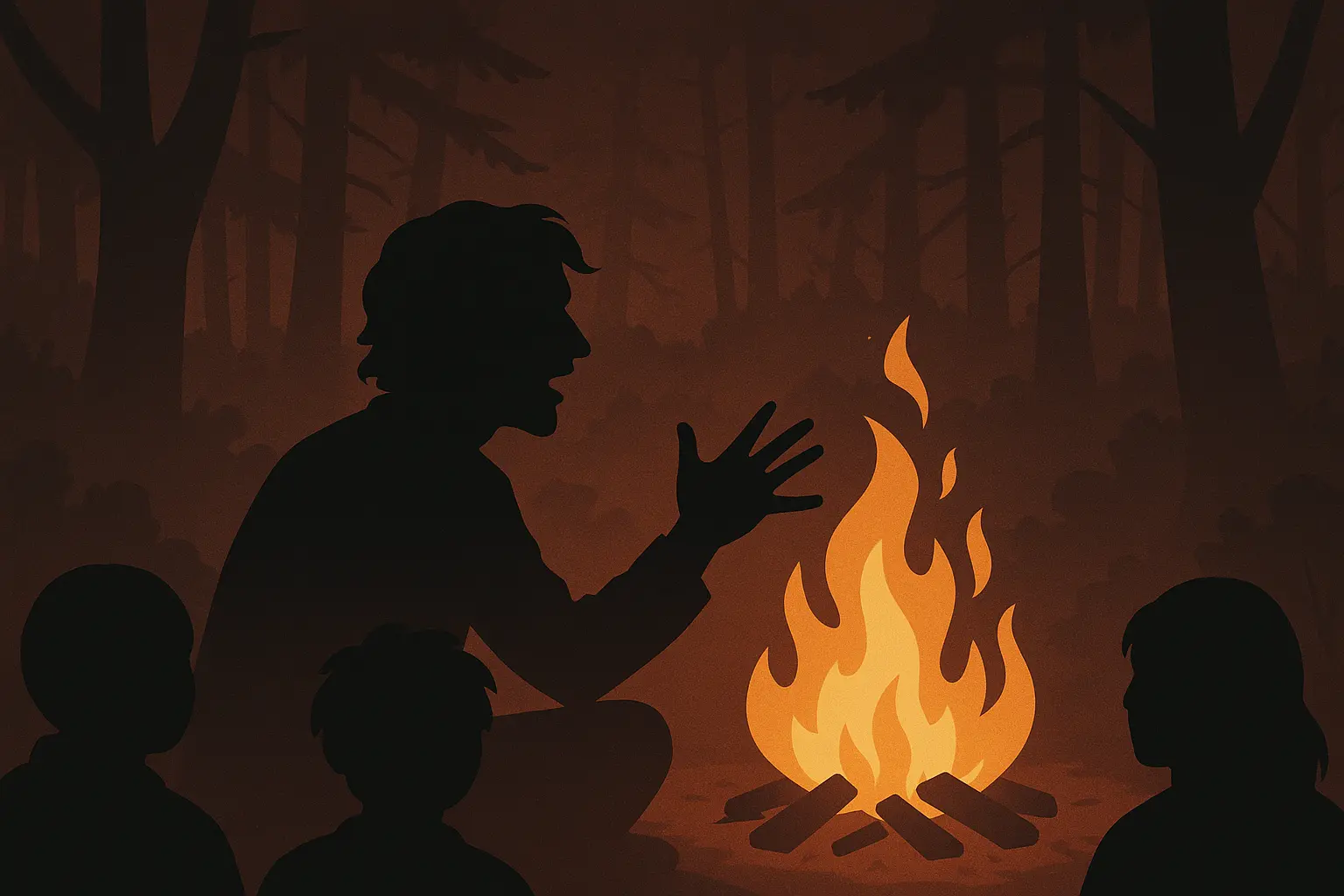
Stories That’ll Actually Scare People (But Won’t Traumatize Kids)
These five stories are the gold standard of campfire horror. I’ve told all of them dozens of times, and they work every single time. Fair warning though—people will be checking their car doors and looking over their shoulders for the rest of the trip.
1. The Hook
This is the story that got me hooked on campfire storytelling in the first place. A young couple is parked at a remote spot when the radio warns about an escaped mental patient with a hook for a hand. They hear scratching sounds, panic, and drive away—only to find a bloody hook hanging from their car door handle.
Why does this story work so well? Because everyone’s been in a car in a remote place and heard weird sounds. It’s relatable fear, and that hook provides the perfect “holy crap” ending that people remember forever.
I once completely messed up the ending because I forgot whether the hook was supposed to be on the driver’s side or passenger side. Just made a quick decision and went with it—nobody cared because they were all too busy being creeped out.
2. The Vanishing Hitchhiker
A driver picks up a young woman on a rainy night, lends her his jacket, and drops her off at her house. When he comes back the next day to get his jacket, he finds out she died in a car accident years ago at the exact spot where he picked her up.
This one’s great because it’s not really scary—it’s more mysterious and sad. The jacket is the perfect physical proof that something supernatural happened, and it leaves people wondering rather than jumping at shadows.
3. The Babysitter and the Man Upstairs
A teenage babysitter gets increasingly creepy phone calls asking if she’s “checked the children.” When she finally calls the police, they trace the calls and tell her to get out immediately—the calls are coming from inside the house.
This story taps into that basic fear of home invasion and being responsible for other people’s safety. Most people have either babysat or been babysat, so it hits close to home. The phone calls build tension perfectly, and that reveal never gets old.
4. Bloody Mary
The classic bathroom mirror ritual—say “Bloody Mary” three times in a dark bathroom while looking in the mirror, and she’ll appear. Usually results in scratched faces, terrifying visions, or the person just disappearing entirely.
What makes this one special is that people can actually try it if they’re brave enough (spoiler alert: most aren’t). It’s interactive fear that extends beyond just hearing the story. Plus, everyone has weird feelings about mirrors in the dark anyway.
5. The Girl with the Green Ribbon
A woman wears a green velvet ribbon around her neck her entire life and refuses to explain why, even to her husband. Finally, on her deathbed, she lets him untie it—and her head falls off.
This story is wonderfully weird. It builds mystery through one unexplained detail that gets more intriguing over time. The ending is shocking but not gory, making it perfect for mixed-age groups. Yes, it’s totally bizarre, but something about telling it around a campfire just works.

Spooky Stories That Won’t Give Anyone Nightmares
These four stories hit that sweet spot of being atmospheric and mysterious without being genuinely scary. Perfect for when you want some supernatural vibes but don’t want to deal with anyone having trouble sleeping later.
6. The Phantom Camper
Every year at the same remote campsite, people report seeing a lone figure tending a campfire that vanishes when approached. Turns out it’s the ghost of a camper who died in a forest fire decades ago, still keeping his eternal watch.
Look, this sounds ridiculous when I describe it, but something about telling it around an actual campfire just works. It’s directly related to what everyone’s doing right now, and the phantom camper is more protective than threatening. I’ve never had anyone get genuinely scared by this one.
7. The Crying Woman (La Llorona)
A grief-stricken woman who drowned her children now wanders near water at night, crying and searching for them. Sometimes she mistakes other children for her own, which can be dangerous for families camping near lakes or rivers.
This is a beautiful, sad story with real cultural depth. It works especially well if you’re camping near water, and it naturally leads to conversations about staying close to adults and being careful around water at night.
8. The Wendigo
In harsh northern winters, people who resort to cannibalism transform into eternally hungry creatures that hunt other humans. These wendigos have supernatural strength and an insatiable appetite for human flesh.
This one carries genuine cultural significance and provides good scares without being gratuitously gory. Forest settings make it extra effective, and it opens up interesting discussions about survival ethics and what people might do in desperate situations.
9. The Black-Eyed Children
Strange children with completely black eyes show up at doors, cars, or campsites, politely asking for help or to come inside. People who help them face terrible consequences, while those who refuse find the children mysteriously vanish.
This modern urban legend is genuinely unsettling without being violent. The politeness makes it creepier somehow—these aren’t monster children, they’re eerily well-behaved children who just happen to have completely black eyes. It taps into contemporary stranger danger fears while keeping things supernatural.
Funny Stories for When Things Get Too Intense
These four stories are perfect for lightening the mood after you’ve thoroughly creeped everyone out. They work for all ages and help bring the group back together with some good laughs.
10. The Ghost Who Couldn’t Scare Anyone
A well-meaning ghost tries every haunting technique in the book but fails spectacularly at each attempt. His chains get tangled, his sheets tear at the worst moments, and his terrifying “boos” sound more like sneezes.
This one’s great because it completely flips scary story expectations. Kids especially love it, and you can get the audience involved by asking them to suggest other ways the ghost could mess up. I once had a group of 8-year-olds contributing ideas for twenty minutes—they came up with funnier failures than I ever could have.
Pro tip: When telling this story, really ham it up. Make the ghost sound frustrated and pathetic. The more ridiculous you make it, the better it works.
11. The Camping Bear
A supposedly dangerous bear keeps “stealing” campers’ food but leaves polite thank-you notes and even does helpful camp chores in return. Eventually, campers learn to coexist peacefully with their polite ursine neighbor.
This story works great for nervous first-time campers because it addresses real bear concerns through humor. It also teaches good lessons about wildlife coexistence and proper food storage, just in a silly way that people actually remember.
12. The Backwards Day
12. The Backwards Day
A camper wakes up in a world where everything happens in reverse—people walk backwards, talk backwards, even time moves backwards. The protagonist has to figure out how to navigate this topsy-turvy world and get things back to normal.
This silly concept appeals to all ages and practically begs for audience participation. Let people contribute backwards words or actions—it keeps restless groups engaged and turns the story into a group activity.
13. The Snoring Dragon
A “terrifying” dragon that’s been keeping an entire village awake turns out to have severe sleep apnea. The villagers solve everyone’s sleep problems by crafting a medieval CPAP machine from hollow logs and forest materials.
This modern twist on classic dragon tales is especially funny for adult audiences who get the medical reference. It addresses the relatable problem of loud snoring while promoting creative problem-solving. Plus, it’s just absurd enough to get everyone laughing.
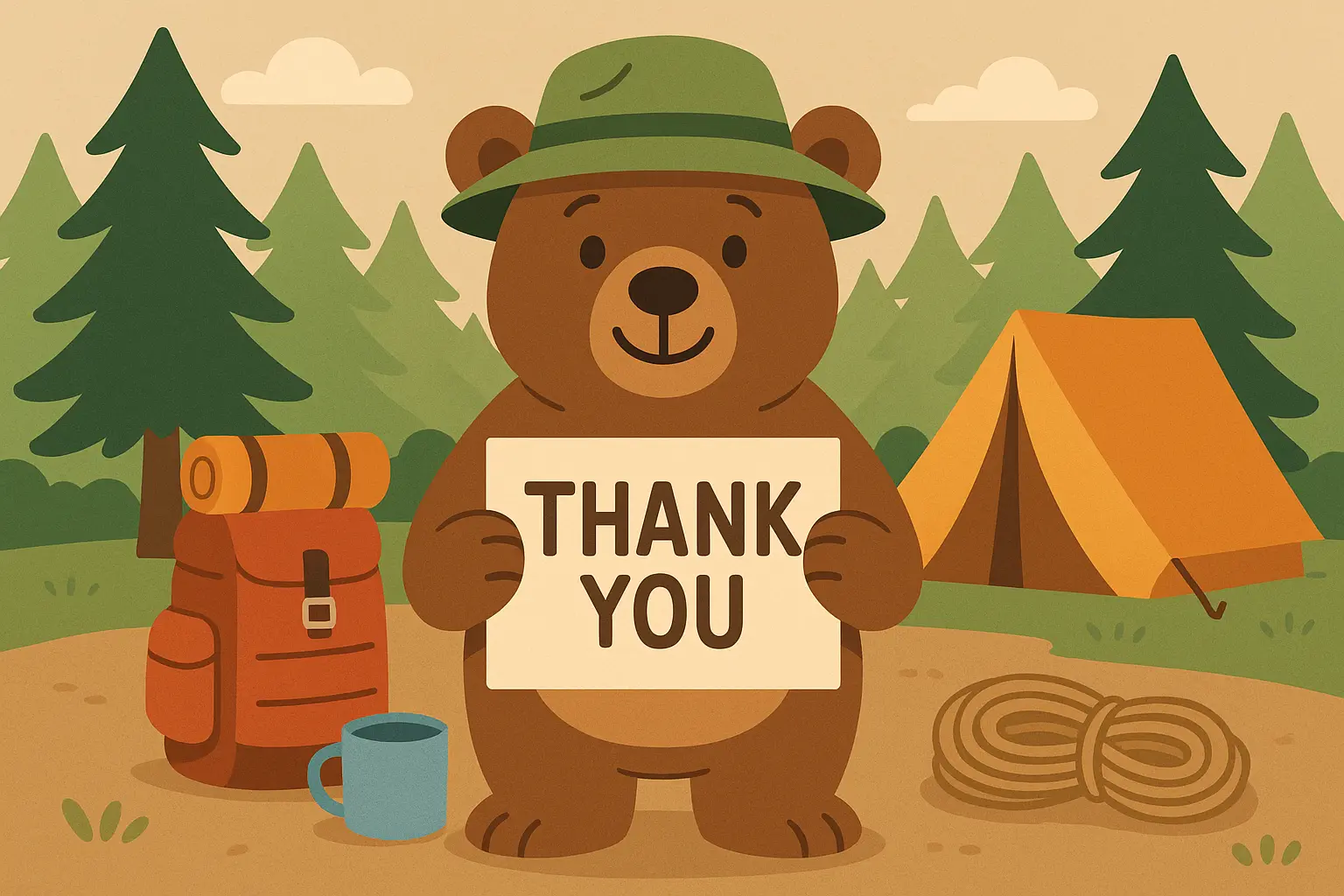
Weird Stories That Somehow Always Work
These four stories are more mysterious than scary, perfect for audiences who want something supernatural but thoughtful. They’re complex enough to keep adults engaged while still being accessible to younger listeners.
14. The Time Loop Campsite
Campers realize they’re reliving the same day at their campsite over and over, with small changes each loop. They have to solve an ancient mystery connected to the land to break free from the time prison.
This one requires an audience that actually pays attention to complex stuff, but when it works, it really works. The repetitive structure helps people follow the loops, and you can have fun with the small changes each time. Just don’t attempt this with a group that’s already had a few beers.
15. The Forest That Walks
Trees in an ancient forest move when no one’s looking, rearranging paths and clearings to protect a secret at the forest’s heart. Campers get lost as familiar landmarks shift, forcing them to earn the forest’s trust through respectful behavior.
This story uses your actual surroundings perfectly. Every creaking branch and rustling leaf becomes part of the narrative. It’s also a great way to teach environmental respect without being preachy about it.
16. The Campfire That Burns Forever
A mysterious eternal campfire has burned for centuries, maintained by the spirits of everyone who’s ever gathered around it. Each person who shares a story becomes part of its eternal community, connecting all storytellers across time.
This is basically a story about storytelling itself, which sounds pretentious but actually works really well around an actual campfire. It celebrates the tradition you’re all participating in and makes everyone feel connected to something bigger.
17. The Echo Valley
A valley where sounds don’t just echo—they return as messages from the past or future. Campers learn to interpret these time-traveling communications to solve mysteries or get guidance about their lives.
The interactive element is what makes this story special—you can actually test echoes while telling it, blending reality with fiction. It encourages listening skills and gets people experimenting with sounds, which keeps everyone engaged even if they’re not totally following the plot.
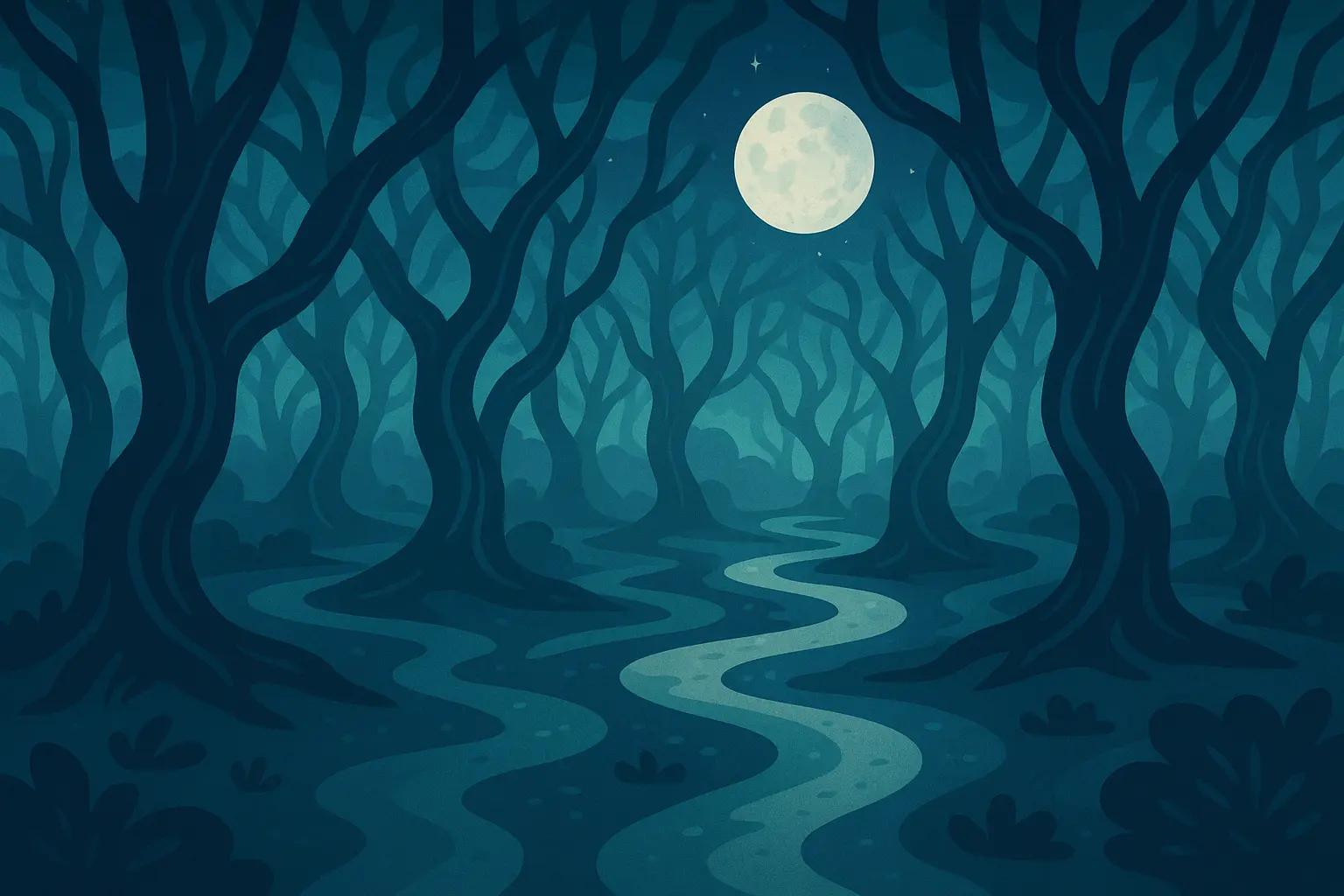
Adventure Stories That Make Everyone Feel Good About Being Outside
These four stories focus on resourcefulness, teamwork, and positive outdoor experiences. They’re perfect for when you want to celebrate being in nature rather than making everyone paranoid about it.
18. The Lost Compass
A hiker’s compass stops pointing toward magnetic north and instead points toward whatever they most need—water during drought, shelter during storms, or the path home when lost. The magical instrument reveals its true purpose through helping others.
This story teaches actual navigation skills while being inspirational rather than scary. The compass works as a metaphor for trusting your instincts, and it encourages people to think about preparedness without being preachy about it.
19. The Storm Shelter Cave
Campers seeking shelter during a sudden storm discover their cave has been used by travelers for centuries. Messages, supplies, and artifacts left by previous visitors create a sense of community across time and cultures.
This one emphasizes human kindness and preparedness. It makes people think about their own impact on places they visit and the importance of helping future travelers. Plus, it’s just a nice story that makes everyone feel good about humanity.
20. The Rescue Dog Ghost
A legendary search and rescue dog continues helping lost hikers even after death, appearing to guide them to safety before mysteriously vanishing. The spirit dog represents the eternal bond between humans and their animal companions.
Perfect for animal lovers, and it promotes outdoor safety without being scary about it. It provides comfort to nervous hikers while teaching the importance of staying on trails and carrying emergency supplies.
21. The Survival Challenge
A group of friends must use only natural materials to solve problems during an unexpected wilderness emergency. Through teamwork and resourcefulness, they learn valuable survival skills while strengthening their friendships.
This educational story lets you sneak in actual survival tips while keeping everyone entertained. The group dynamic elements get people talking about teamwork and problem-solving, making it great for team-building camping trips.
| Weather | What Actually Works Best | How to Adjust Your Delivery | Good Story Examples |
|---|---|---|---|
| Clear, Starry Night | Cosmic tales, time stories, philosophical stuff | Normal volume, encourage stargazing | “The Star Bridge,” “Time Loop Campsite” |
| Windy | Short, simple stories with strong plots | Speak louder, shorter pauses | “The Hook,” “The Ghost Who Couldn’t Scare” |
| Light Rain | Cozy, heartwarming tales, gentle mysteries | Softer, more intimate delivery | “The Camping Bear,” “Storm Shelter Cave” |
| Foggy/Overcast | Spooky, mysterious stories | Use the limited visibility for atmosphere | “The Phantom Camper,” “The Forest That Walks” |
Cultural Stories (That Respect Their Origins)
These four stories celebrate diverse cultural heritage while teaching universal values and environmental stewardship. I try to be respectful of their origins while adapting them for campfire settings.
22. The Fire Keeper
An ancient tale about the first humans who learned to make fire and the great responsibility that came with this powerful gift. Adapted respectfully from various cultural traditions, it emphasizes fire safety and respect for natural forces.
This story connects directly to what everyone’s doing around the campfire while teaching important lessons about responsibility. I focus on universal themes rather than specific cultural details to keep it respectful.
Drawing from traditional storytelling wisdom, these cultural tales share common elements with folktale story examples that have been passed down through generations across different cultures.
23. The Star Bridge
A Native American-inspired story about how the Milky Way formed as a bridge for spirits, best told while stargazing around the campfire. The tale connects earthly campfire experiences with cosmic wonder and spiritual beliefs.
Pro tip: Double-check that it’s actually a clear night before you commit to telling star stories. I learned that one the embarrassing way when I spent ten minutes talking about the beautiful Milky Way above us on a completely overcast night.
24. The Trickster’s Lesson
A classic trickster figure teaches campers important lessons about nature, respect, and humility through clever schemes and unexpected outcomes. Adapted from various cultural traditions while focusing on universal moral lessons.
Trickster stories appear in cultures worldwide, so you can adapt this to different regional contexts while being respectful. The moral lessons emerge naturally through entertaining scenarios rather than heavy-handed preaching.
25. The Council of Animals
Animals hold a secret meeting to discuss how to coexist with human campers, revealing the forest’s perspective on camping etiquette and environmental stewardship. The story promotes Leave No Trace principles through animal viewpoints.
This environmental education story teaches practical camping ethics while being entertaining. The animal perspectives help people understand their impact on natural environments without making them feel guilty about being there.
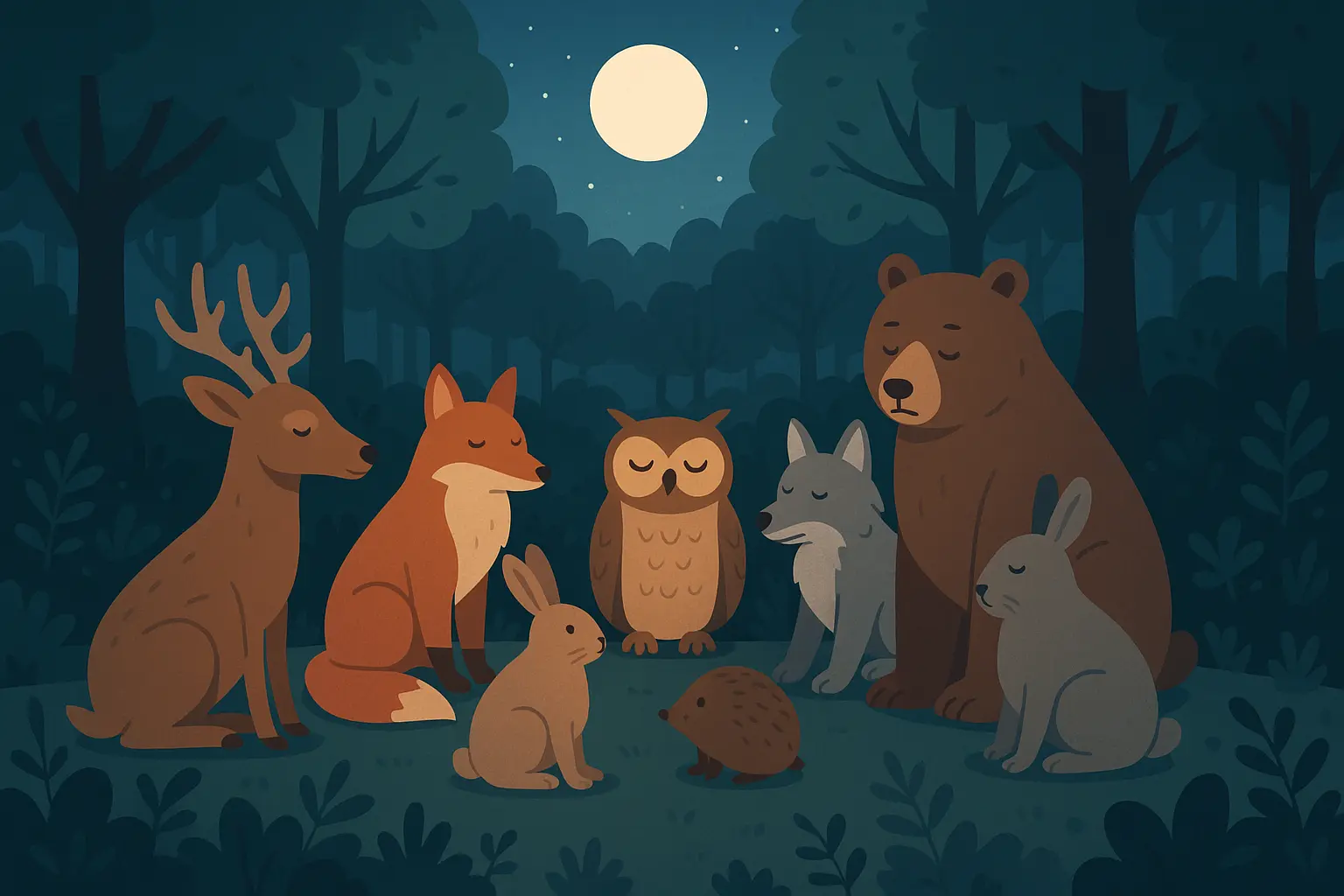
How to Actually Tell These Stories (Without Looking Like an Idiot)
Here’s what I wish someone had told me before my first few campfire disasters: you don’t need to be a professional actor, but a few simple techniques will make you way more effective.
The Real Deal on Story Scripts and Delivery
Memorizing key plot points works way better than trying to remember exact words. I learned this after completely butchering “The Hook” because I forgot the ending halfway through—but you know what? Everyone still loved it because we were all laughing at my mess-up.
Voice changes help people keep track of characters, but you don’t need to get fancy about it. Just slightly different tones work fine:
– Normal voice for narration: “Sarah picked up the phone on the third ring…”
– Higher, nervous pitch for Sarah: “Hello? Johnson residence…”
– Deeper, creepier tone for the caller: “Have you checked the children?”
– Urgent whisper for police: “Get out NOW. The calls are coming from inside.”
Pacing is everything, but it’s simpler than people make it sound. Start slow to set the mood, build gradually toward the scary part, then deliver that final punch. When in doubt, just pause. Silence builds suspense and gives you time to remember what comes next.
Understanding the fundamental principles of effective narrative structure, as outlined in our guide on how to write a story, can significantly improve your campfire storytelling delivery and audience engagement.
Getting People Involved (Without Losing Control)
Simple interaction works best. Ask “What would you do?” at decision points. Let kids make sound effects during action scenes. Have people suggest character names if you forget them mid-story.
Reading your audience is crucial but not complicated. Fidgeting means speed up or add interaction. Wide eyes mean keep doing what you’re doing. Nervous laughter during scary parts means you’re hitting the right level.
Kids will interrupt with questions—embrace it instead of fighting it. “Is the ghost real?” “What happened to the hook man’s other hand?” These questions mean they’re engaged. Answer quickly and get back to the story.
Someone will always need to use the bathroom right at the climax. It’s like a law of nature. Just pause, let them go, and pick up where you left off. Don’t try to rush through the good parts.
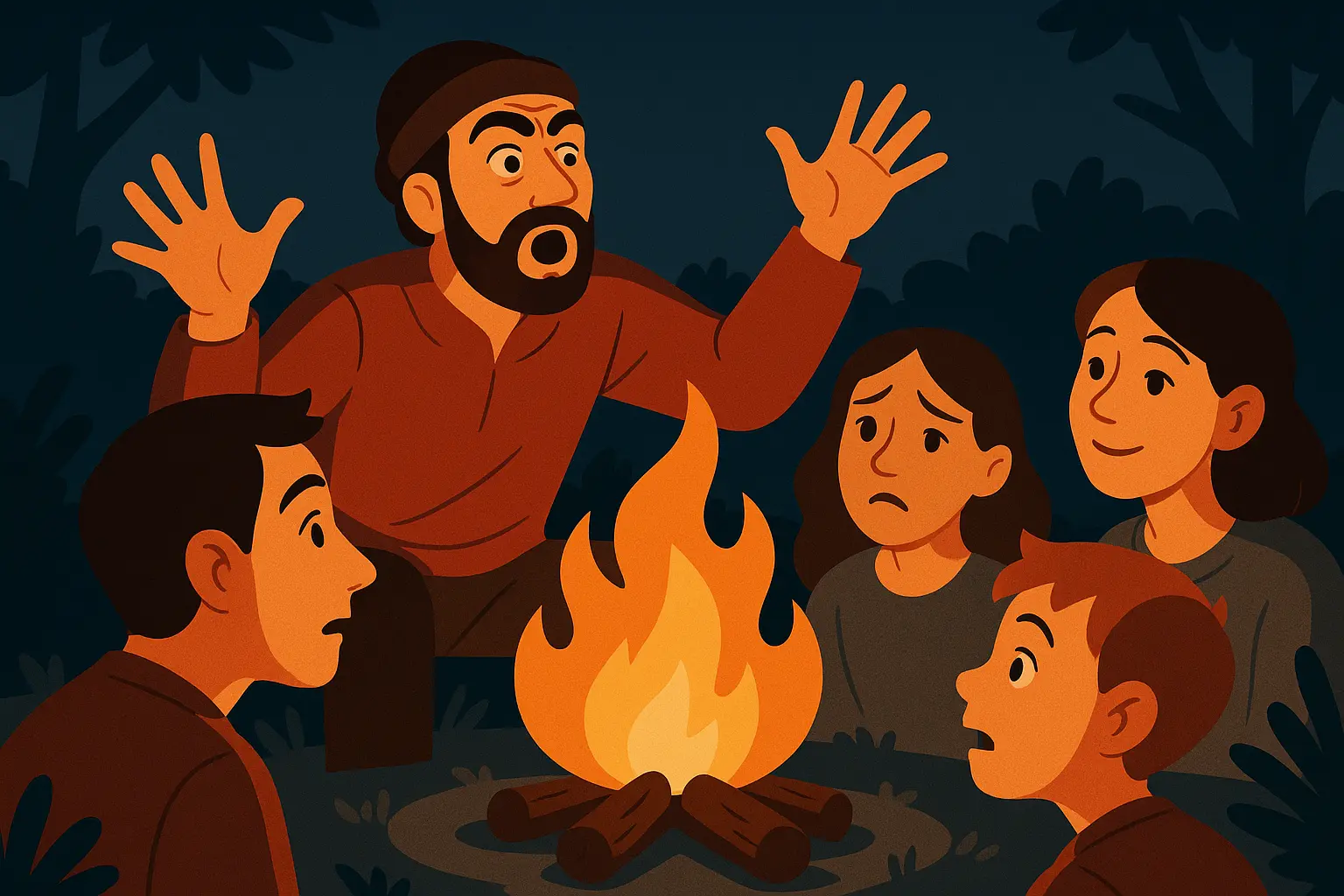
How to Pick the Right Story (Without Overthinking It)
Here’s my simple system for figuring out what to tell without getting all academic about it.
Age-Appropriate Stuff That Actually Makes Sense
All-ages stories (5 to adult) stick to humor, adventure, or gentle mysteries. Think funny ghost stories, helpful animal tales, and simple adventures. Nothing that’ll give anyone nightmares or require a philosophy degree to understand.
Teen and adult stuff (13+) can include moderate scares and complex themes. These are your classic scary stories, cultural legends with deeper meaning, and psychological mysteries that require sustained attention.
Adult-preferred stories (18+) feature complex narratives, intense psychological elements, or sophisticated cultural themes that younger audiences just won’t connect with.
How Well Stories Work in the Woods
Maximum enhancement stories are made for campfire settings—phantom campers, eternal fires, forest councils, survival challenges. These feel naturally connected to outdoor environments and benefit hugely from campfire atmosphere.
Good enhancement stories work well outdoors but don’t require camping settings. Your classic scary tales, cultural legends, and adventure stories adapt well to campfire environments while working fine elsewhere too.
Some stories can be adapted to outdoor settings but don’t inherently benefit from them. Urban legends and domestic horror stories fall into this category—they work fine around a campfire but don’t feel specifically outdoorsy.
| Story | Fear Level (1-10) | Who It’s For | Works Well Outdoors? | Will People Remember It? |
|---|---|---|---|---|
| The Hook | 8 | 13+ | Yes | Definitely (but someone always asks about which hand) |
| Phantom Camper | 5 | 8+ | Perfect for camping | Yes |
| Ghost Who Couldn’t Scare | 2 | Everyone | Good anywhere | Sort of |
| Time Loop Campsite | 4 | 16+ | Made for camping | Yes (if they follow complex plots) |
| Camping Bear | 1 | Everyone | Perfect for camping | Kind of |
| Wendigo | 9 | 16+ | Great in forests | Definitely |
| Star Bridge | 2 | Everyone | Best under stars | Somewhat |
| Council of Animals | 1 | Everyone | Perfect for camping | Moderately |
What Makes Stories Stick in People’s Heads
The most memorable stories have
The most memorable stories have simple, straightforward plots with strong visual endings. “The Hook,” “The Girl with the Green Ribbon,” and “The Phantom Camper” are perfect examples—clear progression and unforgettable conclusions.
Some stories have good bones but might require notes or practice for smooth delivery. Most cultural tales, adventure stories, and complex mysteries fall here.
Complex stories require experienced storytellers and attentive audiences. Time loop narratives, multi-character tales, and stories with multiple plot threads need careful planning and practice.

Advanced Tricks for When You Want to Get Really Into It
Once you’ve mastered the basics, here are some techniques that’ll make you the storyteller people specifically request for camping trips.
Working with Weather (Instead of Fighting It)
Clear, starry nights are perfect for cosmic tales and time-spanning stories. “The Star Bridge” and “The Time Loop Campsite” work exceptionally well when people can actually see the stars you’re talking about.
Windy conditions call for shorter stories with simpler structures. You’ll need to speak louder, and wind sounds can enhance forest-based tales but will interfere with complex narratives that require careful attention to dialogue.
Light rain creates intimate, cozy atmospheres perfect for heartwarming tales or gentle mysteries. The sound of rain on tent fabric provides natural background ambiance for stories about shelter, community, or protection.
Overcast or foggy nights enhance mysterious and spooky content. Limited visibility increases audience focus on your voice while creating natural atmosphere for supernatural tales.
Using Natural Sounds Like a Pro
Owl calls provide perfect punctuation for supernatural stories. When you hear one, just pause your narrative and let the owl “participate” in the story. Then incorporate it: “And just then, as if the forest itself was warning them…”
Water sounds from nearby streams, lakes, or rain enhance stories involving water spirits, time travel, or cleansing themes. “The Crying Woman” and “Echo Valley” benefit significantly from natural water acoustics.
Wind through trees creates atmospheric enhancement for forest-based tales. Instead of competing with wind sounds, use them as natural sound effects: “The trees whispered warnings that no one heeded…”
Fire crackling works for all campfire stories, but it’s especially effective for tales directly involving fire, eternal flames, or stories about warmth and human connection.
For those seeking to develop their own original campfire story content, our short story examples provide excellent inspiration for creating memorable narratives with strong emotional impact.
Planning Themed Story Sessions
“Lessons from Nature” sessions combine environmental education with entertainment. Start with “The Fire Keeper” to establish respect for natural forces, progress through “The Wendigo” to explore consequences of disrespecting nature, include “The Rescue Dog Ghost” for protective natural spirits, and conclude with “The Council of Animals” for mutual respect and coexistence.
“Time and Memory” themes explore how past and present intersect. Begin with “The Vanishing Hitchhiker” for past-present connections, develop through “The Time Loop Campsite” for breaking cycles, explore “The Eternal Campfire” for continuity of human experience, and end with “The Star Bridge” for cosmic time perspectives.
“Community and Connection” sessions celebrate human relationships and cooperation. Start with “The Camping Bear” for unexpected friendships, move to “The Storm Shelter Cave” for human connection across time, include “The Survival Challenge” for teamwork, and conclude with “The Trickster’s Lesson” for learning from others.
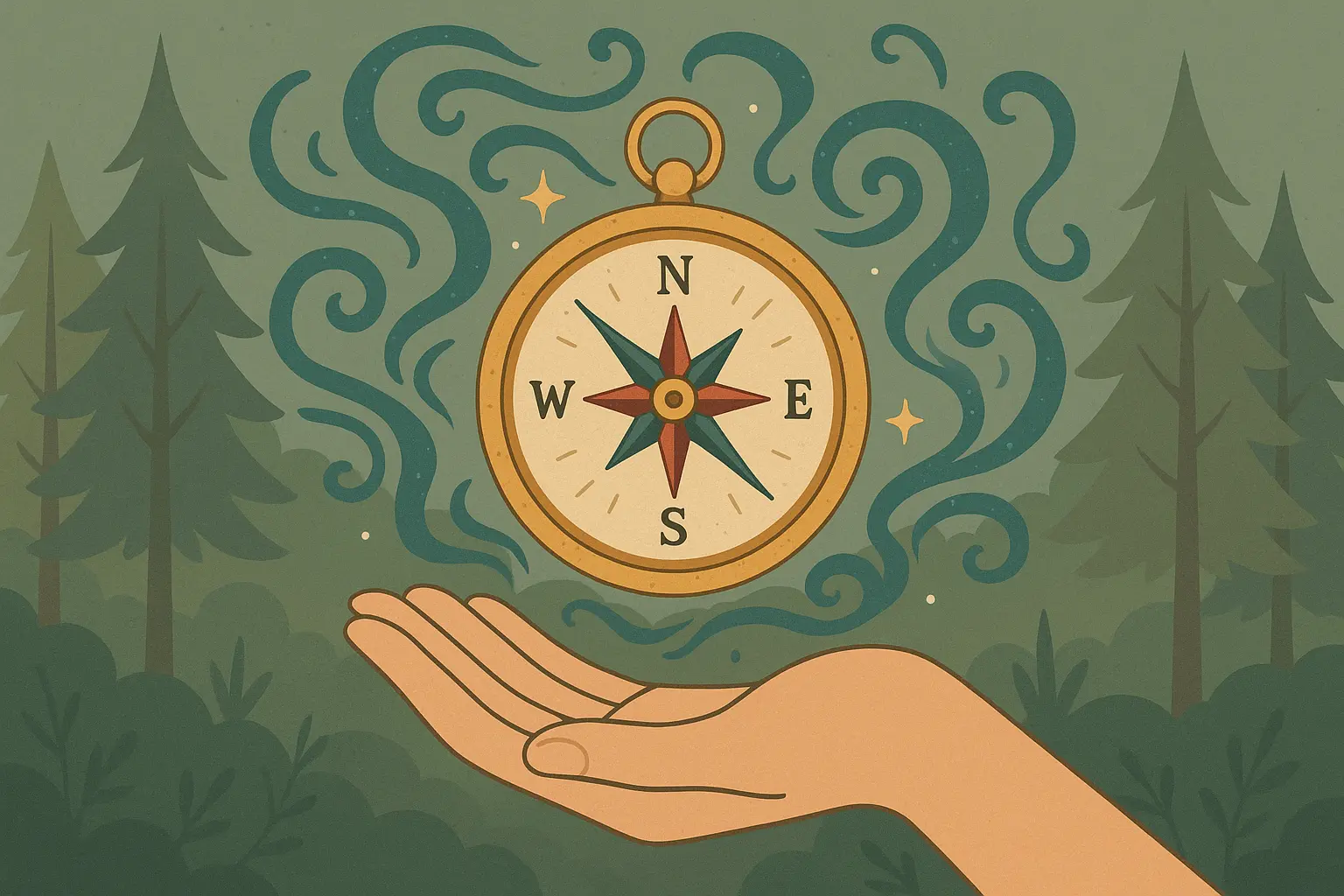
When You Completely Blank Out (And How AI Can Save You)
Look, I’ll be honest—sometimes you just completely blank when everyone’s looking at you to tell a story. That’s where tools like Nairrate come in handy. It’s basically like having a storytelling buddy who never runs out of ideas.
Real Campfire Problems That Actually Happen
Even experienced storytellers sometimes face those awful blank mind moments around the campfire. You know the feeling—everyone’s staring expectantly, the fire’s crackling dramatically, and your brain just… nothing. Nairrate’s Story Prompt Generator provides instant inspiration tailored to your specific audience and setting, so you’re never stuck going “umm…” for thirty seconds.
Sometimes you need to adapt on the fly. Maybe “The Hook” is too intense for the kids who just joined your group, or you want to make “The Phantom Camper” specific to the actual campsite you’re at. Nairrate’s Story Starters Generator helps you craft compelling openings that transform familiar tales into personalized experiences.
Interactive opportunities come up naturally during campfire sessions, but thinking of them on the spot is hard. Use Nairrate’s tools to generate alternative plot twists, develop character backgrounds, or create multiple endings that let your audience choose their own adventure paths.
Whether you’re crafting a gentle spooky campfire story for mixed ages or developing complex narratives, Nairrate’s story idea generator can help spark creativity and overcome storytelling blocks during your outdoor adventures.
Making Stories Your Own
Nairrate’s AI understands how stories actually work and helps you compress longer tales into campfire-appropriate lengths without losing the good parts, generate atmospheric descriptions that work with your specific outdoor setting, create distinctive character voices that bring stories to life, and develop story bridges that connect multiple tales into themed sessions.
Building your personal story collection becomes way easier with intuitive tools. Whether you’re working with local legends, family history, or completely original adventures, the platform helps transform your ideas into compelling narratives that actually work around a campfire.
For storytellers looking to develop their craft further, exploring our collection of anecdote examples can provide valuable insights into creating personal, memorable campfire stories that resonate with audiences.
Ready to become the campfire storyteller your group specifically requests? Explore Nairrate’s story generation tools and discover how AI can help you create unforgettable outdoor storytelling experiences that blend classic appeal with personalized touches.
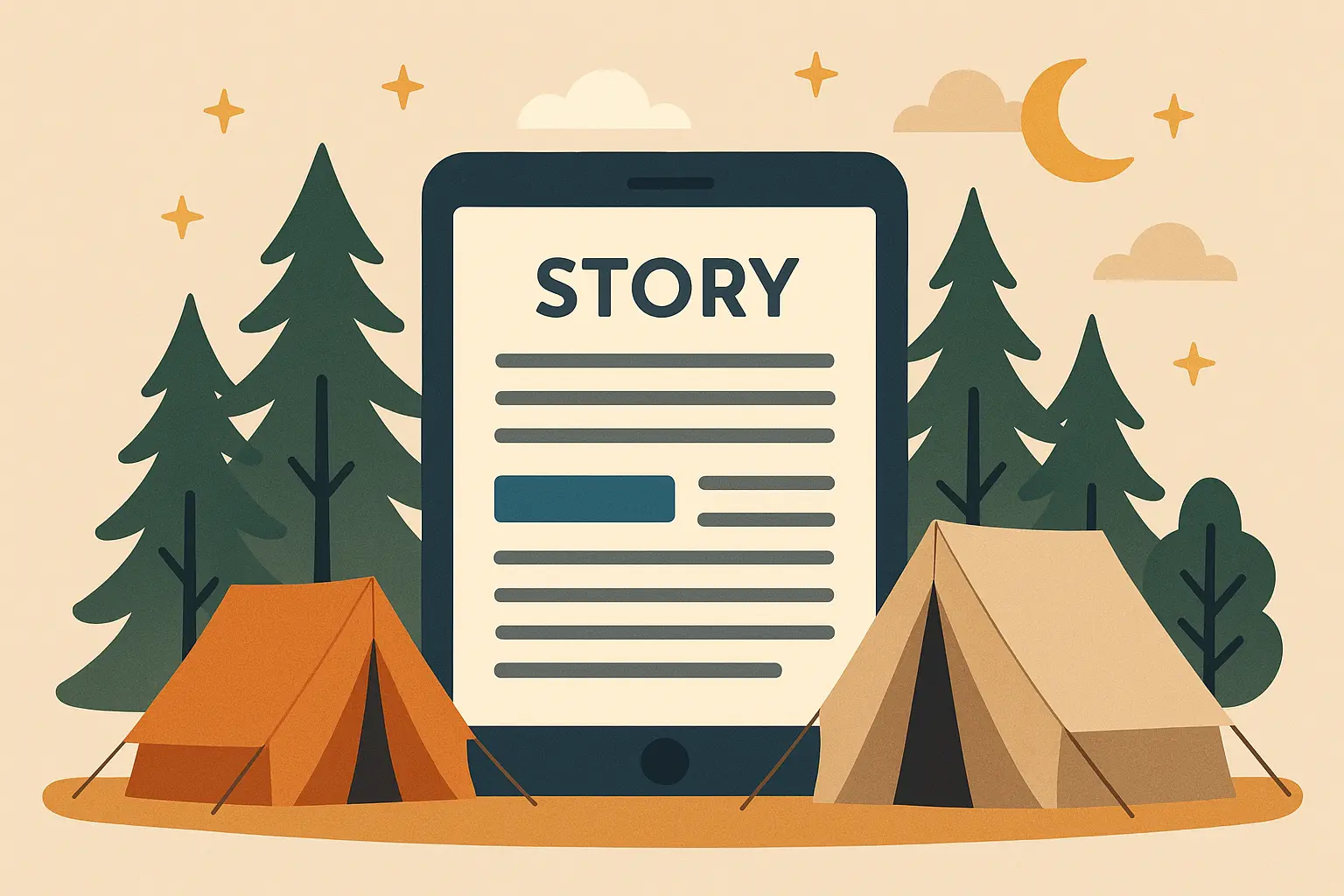
The Real Talk About Campfire Storytelling
Here’s the truth: you ‘re going to mess up stories. You’ll forget endings, mix up character names, and probably have someone’s phone flashlight go off right during the scary part. But that’s actually part of what makes campfire stories special—they’re not perfect, they’re just shared moments around a fire.
Campfire storytelling represents one of humanity’s oldest traditions, connecting us to our ancestors while creating new memories for future generations. These 25 carefully chosen stories provide you with a solid toolkit for any camping situation, from family-friendly adventures to spine-tingling horror tales that will have adults double-checking their tent zippers.
The magic isn’t just in the content—it’s in the delivery and the shared experience. Whether you’re calming nervous first-time campers with gentle humor or thrilling experienced outdoors enthusiasts with complex mysteries, the right story at the right moment can transform an ordinary camping trip into something people talk about for years.
Don’t stress about being the “ultimate storyteller.” Just pick a story that sounds fun to you, practice it once or twice so you know the basic plot, and go for it. The fire, the darkness, and the fact that everyone’s a little tired and relaxed will do most of the work for you.
Remember that storytelling gets better with practice. Start with simpler tales that match your comfort level, pay attention to how people react, and don’t be afraid to adapt stories based on the unique dynamics of each camping group. The flickering firelight, the sounds of nature, and the shared vulnerability of being outdoors together create perfect conditions for stories that touch hearts and spark imaginations.
And hey, if a story completely bombs? Just laugh it off and try a different one. I’ve never met a campfire audience that wasn’t pretty forgiving, especially if you’re genuinely trying to give everyone a good time. Sometimes the stories that go sideways become the most memorable ones anyway.
Most importantly, use your storytelling powers for good. Choose tales that bring people together rather than create lasting anxiety, respect the cultural origins of traditional stories, and use your abilities to foster appreciation for nature and outdoor experiences. The best campfire storytellers don’t just entertain—they create connections between people and the natural world that last long after the embers fade.



Add comment